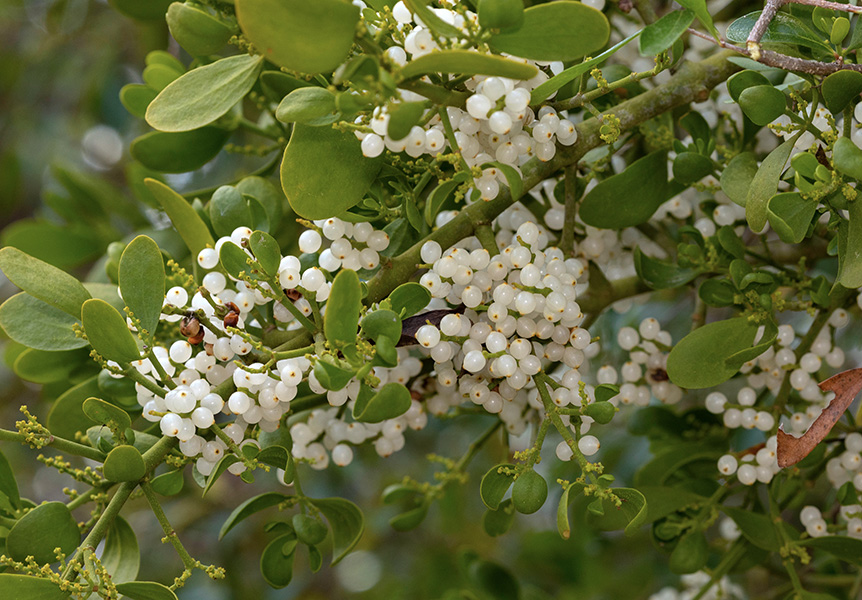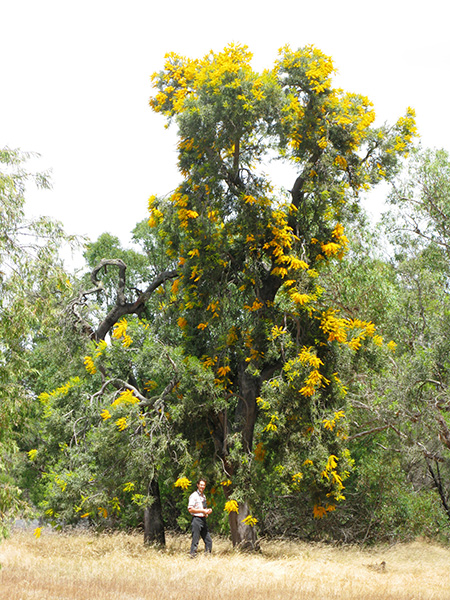Q&A — Community ecologist David Watson
Mistletoes in a warming world
Can the famous parasitic plants help animals to survive climate change, or will they be killed off by extreme weather?
Support sound science and smart stories
Help us make scientific knowledge accessible to all
Donate today
Mistletoe is more than just a Yuletide kissing attraction; it plays a hugely important role in ecosystems. It is a parasitic plant — it takes water and nutrients from a host plant to survive — but it gives back to the environment around it too, providing a food resource for animals, insects and birds. Studies have shown that when you pull mistletoes out of trees, the number of bird species living in that area can drop by more than 25 percent.
And mistletoe plays an important, underrecognized and paradoxical role in the face of climate change.
As ecosystems degrade in our warming world, many animals and birds are coming to rely more heavily on common, berry-bearing parasitic plants like mistletoes. Mistletoes also provide cool havens for nesting birds and welcome shade for animals resting below. They may even help to cool cities. But mistletoes also are exceptionally vulnerable to bouts of extreme weather like droughts. Climate change is taking a heavy toll on them, just as animals come to rely on them more.
David Watson knows these things well. In both academia and the media, he has come to be referred to as “the mistletoe guy” — ever since his student research project stumbled on the fact that certain desert birds were found only in places with mistletoes in the trees. He has since tracked mistletoes across the globe, and coauthored a paper in the 2022 issue of Annual Review of Ecology, Evolution, and Systematics about the role of parasitic plants in a warming world. Watson, a community ecologist at Charles Sturt University at Albury-Wodonga, spoke with Knowable Magazine about the latest results. This interview has been edited for length and clarity.
You write in your review that parasitic plants such as mistletoe are particularly sensitive to environmental stress, like drought or frost. Why is that?
The fundamental reason is just basic physiology. They’ve got no storage organs, no way to store carbohydrates. They’ve got no root system, no bulbs, no rhizomes. So when they lose their leaves, that’s it, they’re screwed. That could happen through herbivory, like if a whole lot of caterpillars come along, or a low-level fire that comes through and crisps up the canopy. If the host plant is drought-stressed and starts to wilt, mistletoes will just curl up and die. They’re weirdly sensitive to a lot of these disturbances. That’s why the world isn't full of them, because they’re actually quite picky. They’re hard to grow.
Do you have some in your backyard?
I do. But all the mistletoes we’ve got are just locals. I’ve tried planting all kinds of exotic ones from my travels, and none of them have worked.

A flowering Casuarina mistletoe in an acacia tree. Mistletoes can create cool spots in tree canopies and welcome shade for animals like kangaroos.
CREDIT: DAVID WATSON
How are these plants faring in the face of climate change?
We see again and again that when climates shift, foods and things that depend on those foods can often be out of sync — a shift to earlier springs, for example, might mean most berries are produced too early for animals that need them later in the season. We’re seeing that mistletoe becomes disproportionately important in many systems because other stuff is out of whack, but mistletoe is still there — it’s reliable. Any month of any year, you can find a mistletoe in most parts of the world that’s either fruiting or flowering. They’re just good at what they do. So there’s increased reliance on mistletoe as a resource.
But then, we’re also seeing mistletoe die-offs. We’re seeing increased sensitivity to disturbances, whether it’s heat waves or drought or fire. So, on the same page, you’ve got animal communities leaning more and more heavily towards this group of plants, but those plants struggling to persist.
Can you give an example where these changes are happening now?
My colleague, Francisco Fontúrbel, works in southern Chile. Where mistletoe is around, because it’s a reliable nectar source, the southernmost hummingbird (Sephanoides sephaniodes) becomes resident. They pollinate the mistletoes, but they also pollinate all sorts of other plants. After drought, mistletoes die, and those hummingbirds become migrants: They pack up, they follow the nectar further and further north. One study showed mistletoe deaths doubling in the dry year of 2015, and visits from hummingbirds dropped.
When the hummingbirds leave, the local plants don’t have pollinators anymore. This is predicted to trigger a community-wide cascade of extinctions, although that hasn’t been documented yet.
In Australia, large-scale research shows that mistletoe is super-important during drought as a sort of last-ditch nectar resource. But then, that same work shows that drought kills many mistletoes: In the summer of 2009, for example, there was a prolonged heat wave in Melbourne, including the hottest day ever recorded — and nearly 90 percent of a monitored set of mistletoes died. That caused a crash in bird numbers and insect-eating animals.
It’s not across the board. Some tropical systems, some temperate forest systems, are not showing those early warnings of system failure, these mistletoe deaths. But in many arid zones, and in some southern forests at higher latitudes, we’re already seeing food webs breaking down. We don’t want to ring the alarm bells and say the sky is falling, but it’s not looking good.
Are there any models yet to show where this may lead in the future?
No. There’s just so much complexity in terms of the interplay between the mistletoe plant’s natural enemies, pollinators and the host’s seed-dispersal mechanisms. We don’t have a handle on those interactions. We can do really quick-and-dirty models, but it’s just guesswork. They’re not nearly detailed enough to come up with meaningful predictions.
This seems to be a big problem I hear from many scientists: With biodiversity loss and climate change, there are so many unknowns and so many interactions, we just don’t know how badly things can go wrong, or how quickly.
Yeah, that’s right.
Are there ways that mistletoes might help species to weather climate change?
There is now a growing body of work showing that parasitic plants, because they’ve got a very high water content in their tissues, they’re cooler. They create little cool spots in canopies of their host plants compared to surrounding vegetation. You can feel it: You can walk up to a mistletoe, just grab it on a hot day, and it’s cold to the touch. Birds know this: They nest and they rely on this stuff when it’s hot. A nice study showed that kangaroos prefer to rest in the shade under trees with mistletoes, because that shade is a few degrees cooler in the heat of the day.
But climate-change modelers, they don’t necessarily think about the microclimate and characteristics of individual plants or plant groups. A system with parasitic plants has a much greater diversity of climatic microsites than one without it. So it’s going to be key for persistence for many different groups. That’s worldwide.
Is there anything we can do to help mistletoes?
The first thing, as with everything in the environment, is let’s just stop wrecking stuff. Mistletoes are routinely removed from trees by arborists and tree surgeons: They’ve been schooled that it’s bad, it’s a parasite. The work on mistletoes and other parasitic plants affecting host mortality is solid: As a rule, parasitic plants don’t kill their hosts. Let’s start by leaving it alone.

Oak mistletoe, Phoradendron leucarpum, growing in Florida. Mistletoe berries can be an important food source for birds, especially when other plants’ life cycles are shifted by changing climates.
CREDIT: BOB GIBBONS / ALAMY STOCK PHOTO
Second thing: Actively put it back. We’re doing that. In Melbourne, the council wanted to be seen to be proactive about fostering wildlife habitats, even while putting in new roads, putting in new railway infrastructure, and knocking down a lot of trees. So they reached out to me and said, “Hey, can we get some mistletoe in some of our street trees?” We put mistletoes up in there. They have had little babies that are maybe the size of a football now after four or five years. We assumed there was going to be some public blowback, but it was the opposite. People say, “This is great.” I think the tide of opinion is starting to turn.
It’s a bit early to say how that’s going to change things, but we’re really excited about it. There’s growing concern about heat-island effects in cities: all those hard surfaces retaining heat during the day and then radiating out during the night. Some colleagues have shown quite nicely that mistletoe affects the whole water balance of the tree: The whole canopy is cooler when it’s really hot and really dry. So adding mistletoes to street trees could actually help cool cities.
We’re coming up to the season where many people traditionally celebrate mistletoe. Do you have any reflections on this custom?
The kissing thing comes from a druidic ceremony to guarantee a bountiful harvest for the following spring. Think about it: If you’re walking around in a European wooded area in winter, there’s snow on the ground, all the trees have lost their leaves, and you see a green plant up in a tree. I mean, that’s got to be divine, that’s got to be magic. It’s not much of a stretch.
So it was removed with a golden sickle and then passed out to all the farmers to guarantee a prosperous harvest. It was all about fertility, about renewal. Originally, when a ball of mistletoe was hung in a doorway, you could take a berry and that was one kiss.
Many First Nations groups have stories around mistletoe. Noongar people in southwest Australia place huge importance on the world’s largest mistletoe species (Nuytsia floribunda). It’s called the Western Australian Christmas tree. It is giant thing: a 10-meter-high tree with blazing orange, yellow flowers at Christmastime. That’s the spirit tree, where ancestors pause and rest before leaving this world. You’re not allowed to muck with those plants. They’re sacred.

Watson stands underneath a specimen of the world’s largest mistletoe, Nuytsia floribunda, also known as the Australian Christmas tree. Indigenous people in southwest Australia place huge importance on this species.
CREDIT: MAGGIE WATSON
It seems like societies have long recognized the importance of these plants. But maybe mistletoes aren’t given the attention they deserve by ecosystem or climate scientists today?
If you’re not including parasitic plants in your studies — if you’re doing work on herbivory, looking at squirrel home ranges, or the timing of budburst — and you’re not paying attention to parasitic plants, you’re probably missing a trick. Every terrestrial system has parasitic plants — there are no aquatic parasitic plants, which is very cool. There’s now growing evidence that in every system we’ve studied, parasitic plants are disproportionately important to explain what’s going on.
Just keep an eye on those guys, because they’re going to tell you stuff about the system that you probably want to know.
10.1146/knowable-121222-1
TAKE A DEEPER DIVE | Explore Related Scholarly Articles




